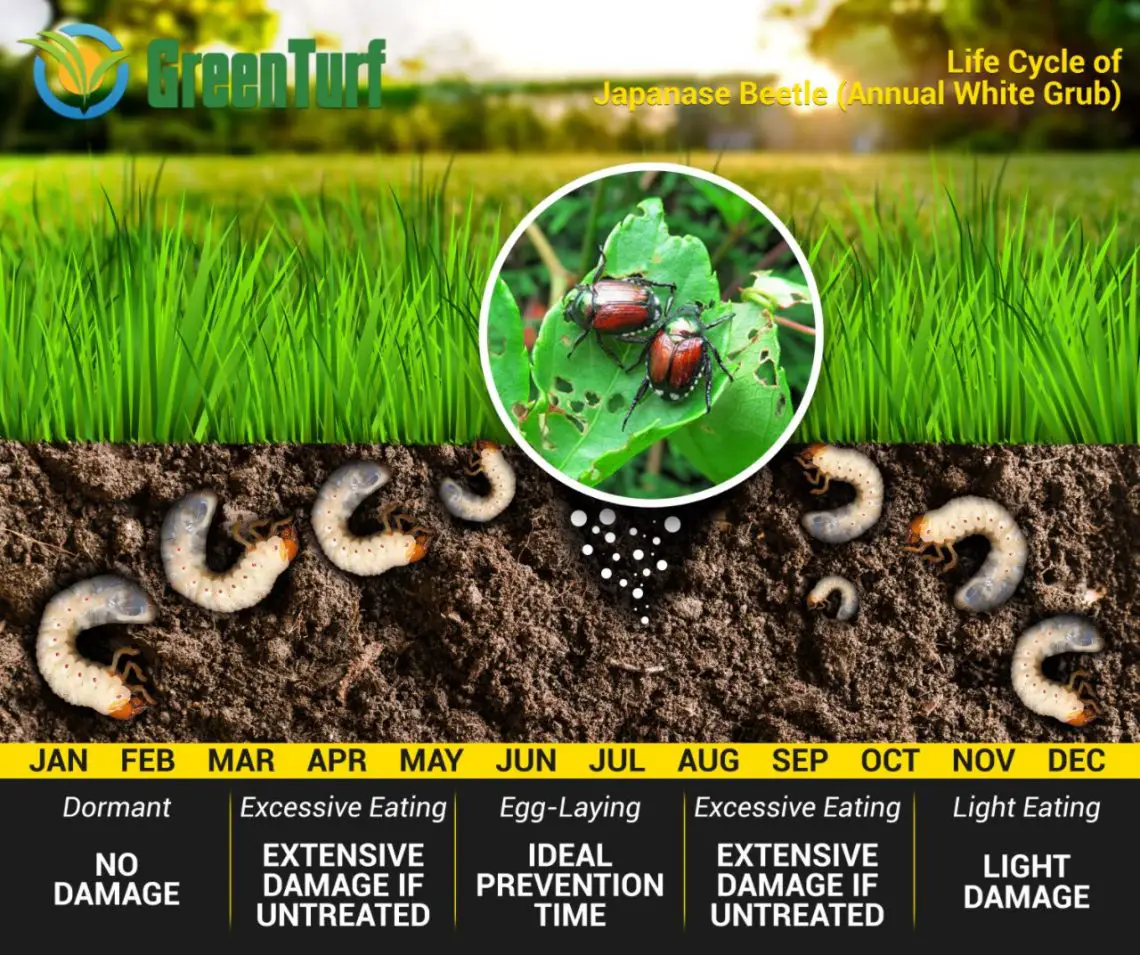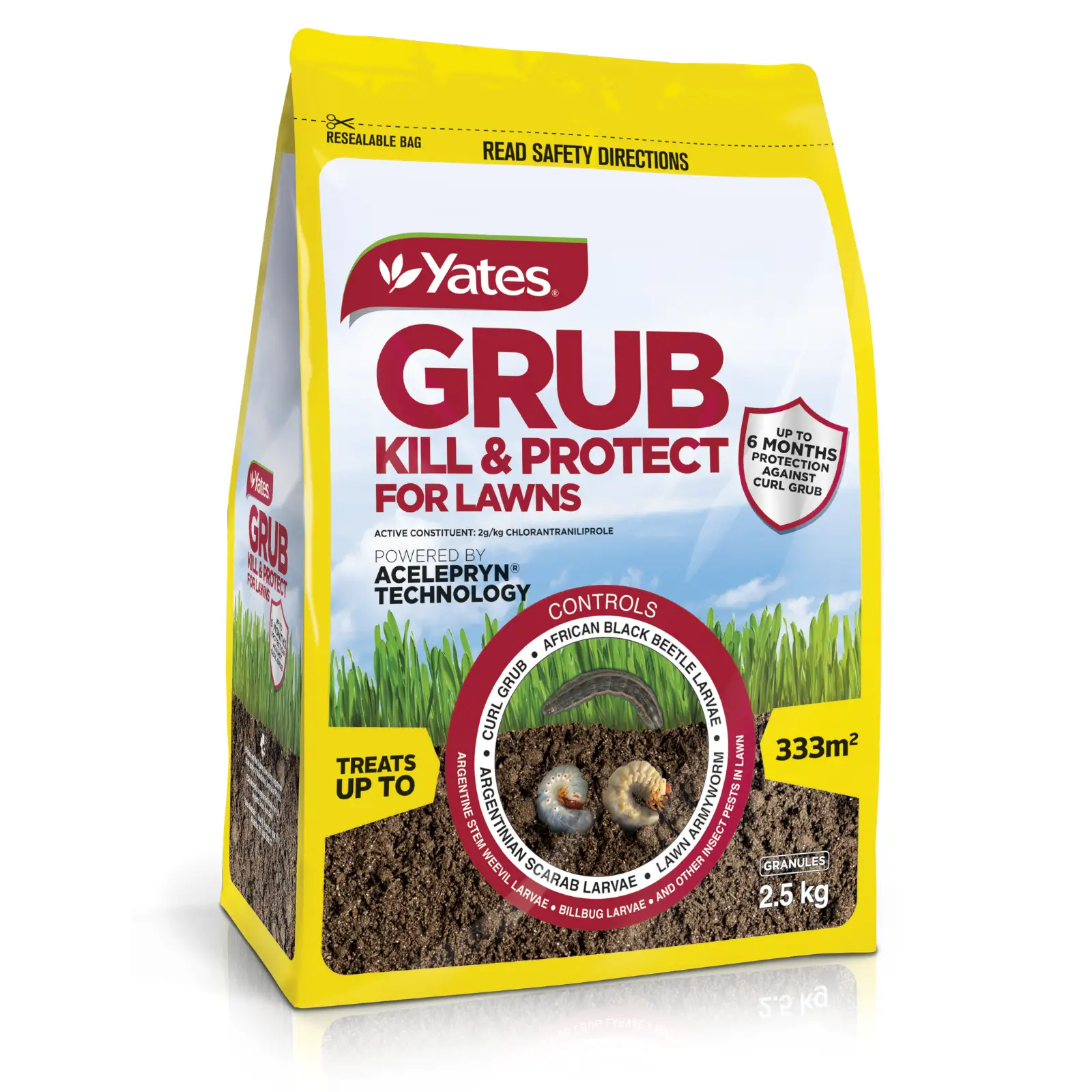How To Get Rid Of Grubs In Lawn: 6 Effective Ways + Natural Control
Alex K.Affiliate Disclaimer: My content may contain links to products I use and love. As an Amazon Associate and participant in various other affiliate programs, I earn a small commission at no extra cost to you from qualifying purchases. I only recommend products I personally vetted!
If there are grubs in your lawn, youll start to notice a change in the shade of your turfgrass. Browning of grass during summer and early fall is a likely sign of white grub worms causing the damage. The key to getting rid of lawn grubs is first identifying their signs, and then applying the best control method as I am going to show you here.
The white grub worms in your lawn are a larval stage of scarab beetles. As soon as winter ends, these worms become active when warmth kicks in. They start to damage your lawn by eating grass roots at a high rate.
If you fail to identify and kill lawn grubs on time, theyll develop into pupae, and later into full-grown beetles. The beetles will later start eating lawn grass and other foliage in your yard, causing even further plant damage.
But how do you know youre dealing with grubs in your lawn and not a disease or other problems?
How To Kill Active Grubs In Your Lawn
Throughout August and September, you may notice your lawn turning brown in certain areas. The chances are your lawn is being invaded by thriving grubs living and feeding below the lawns surface. While it looks unpleasant, grub worms can be controlled with proper treatments, and your lawn can be restored to its appealing and healthy state.
There are some easy-to-apply and effective ways to kill active grubs in your lawn and prevent them from returning next season. By following our tips, you will be able to get back to enjoying your green and good-looking lawn in no time.
Grubs In Lawn Here Is How You Can Get Rid Of Them For Good
Is your lawn patchy and brown? If so, grubs might be the culprit. Grub control products are typically the most extensively advertised and frequently stocked lawn care items at gardening stores, after fertilizer and grass seed. For many households, grub control products are a critical element of their annual lawn care schedule. Lawn grubs can completely devastate your lawn by chewing on the roots of your grass until it vanishes.
Photo by
Photo Disclaimer Images used in this article are owned by the respective individuals, artists, or other parties who post on their private social media accounts. These images only serve for inspiration and cannot be copied for personal use. See Footer for more details. See here for more details.
There is no need to be concerned if you only have a few of these pests, as they are a natural part of the lawn ecosystem. However, if you have found a large number of grubs in your yard, you need to get rid of them as quickly as possible to prevent harm to your grass.
They might destroy the entire lawn if you do nothing to treat a grub infestation. However, you wont have to put up with these pesky lawn pests. Many natural and chemical remedies are available to get rid of lawn grubs for good.
Keep reading to find out!
Also Check: How To Reseed Patches Of Lawn
How To Treat Grub Damaged Lawn
Grubs can be annoying, especially when they interrupt a beautiful growing season. If not careful, the infestations can spread quickly, damaging most of your lawn. Frustrating, yes. Incurable? No.
Youve fully committed to this grass-growing business. So far, its going wonderfully. Youve taken the proper steps to grow, fertilize, and maintain your grass. Except for the fact that despite your best efforts, sections of your grass continue to wilt and die. Not sure why? Well, its more than likely grubs.
In This Article
How To Identify Lawn Grubs

If you suspect your lawn is infested with lawn grubs, here are a few signs to look out for to confirm your doubts.
Increased Bird Activity
One of the first signs that suggest you have lawn grubs is bird activity in your garden. Grubs make a delicious snack for some birds, and youll find them circling your lawn, looking for lunch.
Brown Patches
As your turf recovers from the hot summer temperatures, watch out for brown patches, especially after the fall fertilizing. You can lift some of the turf in the affected area, and if it rolls up easily like a carpet, chances are your lawn is invaded by grubs. Grubs feed on roots therefore, they can weaken your turf and make it susceptible to lawn diseases.
Presence of Grubs in the Soil
Another clear sign of grub infestation is the presence of C-shaped and white worms in the soil. While a few of these harmful pests shouldnt worry you, a large number of them can destroy your beautiful lawn and cause severe damage.
Read Also: How To Spray Your Lawn For Weeds
Chemical Ways To Get Rid Of Lawn Grubs
Chemical control is sure to kill off your lawn grubs, but it comes at a costusing these treatments can kill beneficial insects, too. There are two types of chemical treatments.
Can You Apply Grub Control Too Early
If you want to prevent grub damage next season, there is a commercial product that allows you to go out in early spring. Most big box stores have consumer products with Imidacloprid which need to be applied from June through July before the grub eggs hatch.
Insecticides are best used in ways that let them be in high concentration at the root zone while the eggs are hatching, and young grubs are present. If the timing is right, you can control about 80 percent of the grubworm infestation for next season.
You May Like: What Is Brushless Lawn Mower
How Bad Are Grubs For The Lawn
Grubs, which are the larval, or immature, stage of several species of beetles and chafers, can damage a lawn by feeding on the roots of your grass. Healthier grass can tolerate more grub feeding, and all grass can tolerate some grub feeding.
A grub infestation will cause patches of thinning turf, and these patches will gradually increase in size. Often times grub damaged grass will pull out very easily at the roots.
What we often hear from homeowners is that they believe they have grubs because animals like moles, skunks, crows and racoons are digging in the lawn. This isnt a reliable clue, however, because grub infestations arent always accompanied by animal damage and animal damage doesnt always result from a grub infestation. These animals feed on other insects in the lawn, like earthworms, which are beneficial to the health of the lawn. That all said, if you do have grubs and animals are digging for them in the lawn, that can be detrimental to the health of your turf and to the appearance of your yard.
What Causes Grubs In Your Lawn
Grubs are unavoidable if you have any sort of lawn or pasture. The problem is that they can cause or attract things that result in massive damage if their numbers get too high. Whether you have a grub infestation, just learned the signs of a lawn grub infestation, or you want to know what you can do to avoid every lawn problem possible, the following information can help you defend your lawn from an abundance of grubs.
Also Check: How To Quote Lawn Mowing
Products To Kill Lawn Grubs
Grub KillaTreating tips when spraying for lawn grubs:
Should I Apply Grubex Before Rain
A very important tip is to water the grub control in within a few days. You can wait for a good rain heading your way, and apply the grub control before the rain. … The chemical in some grub controls will break down in hot, dry weather. So if you leave the chemical on your lawn and not watered in, it won’t be effective.
Also Check: What To Put On Lawn To Make It Green
Kinds Of Lawn Grubs: They All Do The Same Damage
Its irrelevant which species it is, says Shetlar. They cause the same kind of damage.
But here are the lawn grubs you are likely to find right outside your door:
- Japanese beetle grubs are widespread invasive insects, and their white grub larvae are found in lawns all over the country. Japanese beetles can be seen mating at their feeding sites during the day.
How Do Pest Control Experts Get Rid Of Lawn Grubs

Many lawn care companies offer grub control plans that work in a more or less similar manner. First, a lawn care professional will visit your home and begin by inspecting the lawn for signs of lawn grubs and adult beetle activity.
Next, just before the beginning of the hatching season, insect control will be applied. The product gets absorbed by the soil and will remain in the root system to eliminate any grubs that hatch after applying the treatment.
Many lawn care providers also offer customized lawn care plans along with extra services that may be purchased, allowing you to tailor your treatment plan to your specific needs.
Recommended Reading: How Do I Overseed My Lawn
What Does A Grub Look Like
Well, theyre not pretty. Both species have plump, grayish to white bodies with brown heads. They range in size from 3/8 to two inches. They sort of look like a cross between cocktail shrimp and a caterpillar. Perhaps this is because they are slick, shiny, and curled into a C-shape when at rest. They are tiny and hard to see because they bury themselves deep into the roots of your grass. The eggs take anywhere from six to 50 days to hatch before moving on to the next step of larvae. Once they hatch, they begin to feed on your lawns roots devouring everything in sight. Even the healthiest and robust greens can fall prone to the devastating damage grubs can cause.
How To Test Your Lawn For Grubs
Photo by pxhere
If you suspect your grass is plagued with white grubs, you should do a thorough check. However, remember that finding one or two grubs in the soil does not warrant an insect treatment and is perfectly normal.
Nonetheless, here is how you can test your lawn soil for the presence of grubs:
- Conduct a soil survey in August or September the peak activity time for grubs.
- Cut one square foot section of your turf nearly 2 to 4 inches deep in many locations.
- Closely check the thatch, soil, and underside of the turf for the presence of grubs.
Following this, if you see more than ten grubs per square foot, it is time to treat your lawn!
You May Like: How Much Lawn Sprinkler System Cost
Sale Of Bird Seed In 20052008
On January 27, 2012, Scotts Miracle-Gro pled guilty in federal court and paid $4.5 million in fines for selling 73 million units of bird seed between November 2005 to March 2008 that was coated with pesticide known to be deadly to birds and fish. Pesticides were added to protect the product from insects during storage, including Storcide II, that was clearly marked as extremely toxic to birds. Records show that Scotts Miracle-Gro’s own experts warned of the risk in the summer and fall of 2007 but they continued to sell the product until March 2008. In 2008, Scotts Miracle-Gro also falsified pesticide registration numbers required by the U.S. Environmental Protection Agency on its products.
On September 7, 2012, a federal court ordered Scotts to pay a $4 million fine and perform community service for 11 criminal violations of the Federal Insecticide, Fungicide and Rodenticide Act . In a separate agreement with the Environmental Protection Agency, Scotts agreed to pay more than $6 million in penalties and spend $2 million on environmental projects. According to the Justice Department, both the criminal and civil settlements are the largest under FIFRA to date.
A Few Grub Worms Are No Problem A Lot Of Grubs Spell Trouble For Your Yard Learn How To Spot Treat And Prevent A Lawn Grub Infestation
If you have a turf lawn, you almost certainly have lawn grubs. These destructive pests are present during certain times of the year in most parts of the U.S.
Your healthy grass can sustain a little lawn grub damage and be OK. But when grubs proliferate, they can really wreak havoc. Take action before its too late. Read on to learn what you need to about lawn grubs, including how to prevent and eradicate them.
On This Page
- Spongey-feeling grass.
- Grass lifts up like a piece of carpet because its roots have died off.
Of course, another sure way to tell if you have grubs is to actually see them in your soil. Dig down three to four inches in several different sections of soil. An occasional grub is not cause for concern. But if you find more than five grub worms per square foot, Sod Solutions says its time for immediate treatment.
Don’t Miss: How To Naturally Fertilize Your Lawn
Preventive Insecticides That Will Prevent Grub Damage Next Fall And Following Spring
These products are used to prevent future grub problems, not to control the grubs present in the lawn in the spring. They will not work on grubs found in the lawn from the middle of October through the middle of May. However, when applied in June or July they provide excellent protection against the next generation of grubs. So, if you need to apply the preventive insecticide BEFORE the grubs are there, how do you know if you need to use an insecticide or not? If you confirmed grub damage the previous fall or spring, meaning you found lots of grubs, then you may want to use a preventive insecticide for one or two years to build a more dense turf that will be tolerant of grubs. If you have treated for several years and you do not see evidence of grubs in your lawn or in the neighbors lawn, it may be time to stop treating. There is an erroneous philosophy being perpetuated that because we have European chafers and Japanese beetles in the area, it is necessary to treat every year or your lawn will be damaged by grubs. This is not true.
In addition, grub control products that contain the active ingredient chlorantraniliprole are safe for bees, even when weed flowers are sprayed. Finally, avoid spray drift or granular spreader drift to flower beds when applying thiamethoxam, imidacloprid, clothianidin or any insecticide for grubs other than chlorantraniliprole
Controlling Grubs In The Lawn
Beetles, like Japanese and chafer beetles, emerge in early summer, feed on plants in the garden, and lay their eggs in the soil in the lawn. Later in the summer, the grubs hatch and immediately begin to feed. They will continue to eat and grow until mid-fall, when they move deeper in the soil so they can survive through the winter. When the soil warms up again in the spring, the large, mature grubs move back into the upper soil levels, where they transform into adult beetles that emerge in early summer and start the whole process over again.
The key to controlling grubs is to kill them before they hatch and begin to cause damage to your lawn. In spring or early summer, apply a preventative grub control product, such as Scotts® GrubEx®1 to your lawn, following label directions. This is especially important if youve had problems with grubs in the past. One application of Scotts® GrubEx®1 can kill and prevent grubs for up to 4 months.
You May Like: Where To Buy Craftsman Lawn Tractor Parts
Grubs In Lawn: How To Get Rid Of Grubs In The Garden
Grubs in the lawn can go undetected until you notice patches of bare turfgrass in your lush, green lawn. Plump, white, hungry grubs live in the soil and gorge on grass and plant roots. Getting rid of white grubs in the garden is essential to keep lawn grass healthy and green. Thankfully, with the proper care, its possible to stop grubs from causing havoc in your garden.
Getting rid of white lawn grubs involves knowing how to identify them, where to look for them, and how to eradicate them. Of course, to get rid of turf grubs in the soil for good also means preventing them from returning.
This article is a guide to getting rid of lawn grubs using natural, non-toxic grub worm killers. Youll find out how to find the soft, white worm-like creatures and disturb their lifecycle.
Professional Lawn Grub Removal Services

Some homeowners may not want to deal with their grub problem on their own. This isnt typically the role of a pest control service, however. Instead, many lawn care services offer grub control and removal services. Lawncare companies like Lawn Doctor can also help assess the infestation, control the population and then repair the damage. These companies apply a grubworm killer to the lawn that will have an immediate impact on the population.
For larger infestations, the companies may have products that target the grubs feeding on the roots of the grass. They may also have turf care products and services that will restore the damaged lawn after the grubs are under control.
Compare Quotes From Top-rated Landscaping Contractors
Free, No-commitment Estimates
You May Like: How To Repair Mesh Lawn Chair